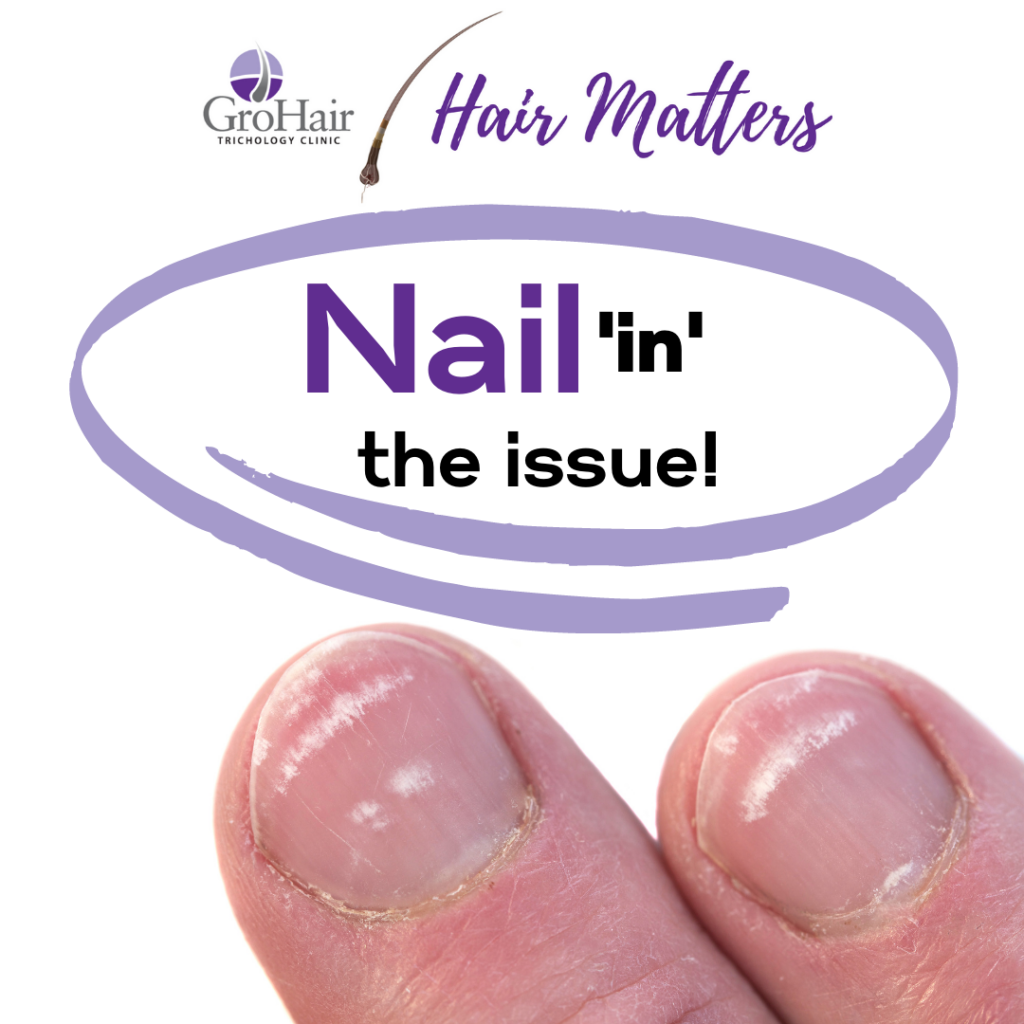
Nailing the issue!
Many patients with scalp or hair loss issues are often surprised by a request to examine their nails, read on to find out why……
Why do we examine the nails?
Just like hair, the nails can provide great insight into a person’s general health and wellbeing. Trichologists and dermatologists will often examine a patient’s nails during a consultation, as they can provide clues as to which scalp/hair condition we may be dealing with. Hair and nails are essentially made of the same material (the protein keratin), so it makes sense that conditions which affect the hair/scalp also have the potential to affect the nails to some degree.
Nail issues are rarely exclusive to just one scalp/hair condition or health issue, nail problems can also exist without any associated cause (idiopathic). It is important to look at the bigger picture and consider all presenting symptoms, medical history, general health, and visual examination (including trichoscopy) before reaching a proposed diagnosis…… nail examination is only part of the picture but can be a particularly useful tool in clinical trichology and dermatology.
Nail issues
The most common scalp/hair issues I have seen in my clinic with accompanying nail abnormalities are Alopecia Areata (patchy hair loss) and Psoriasis. Psoriasis can affect the nails in around 50% of sufferers, and the nails can be affected in various ways. The chart below gives an overview of some of the features a clinician may pay attention to during an examination:
Nail Pitting
| What does it look like? | Associated Scalp/Hair conditions | Other causes |
| This usually appears as small depressions/indentations in the nail surface. Will usually affect numerous nails, can affect both toenails and fingernails. | Alopecia Areata (AA) Nail pitting is the most common nail feature seen with AA and may indicate a more challenging form of the disease. Psoriasis Nail pitting is more prevalent in those with psoriatic arthritis. Dermatitis | Connective tissue disorders Sarcoidosis Trauma to the nail (usually only affects individual nails) |
Spoon Nails (koilonychia)
| What does it look like? | Associated Scalp/Hair conditions | Other causes |
| This is an issue where the nails become extremely thin and form a concave (spoon-like) shape. | Telogen Effluvium: Spoon nails are most associated with iron deficiency. Systemic lupus erythematosus (SLE): Commonly affects the hair in the form of diffuse hair loss. Lichen Planus (LPP) Psoriasis | Raynaud’s disease Thyroid disease Heart disease Nutrient deficiency Chemotherapy/ Radiotherapy Nail trauma (individual nails) |
Beau’s Lines
| What does it look like? | Associated Scalp/Hair condition | Other causes |
| This issue causes grooves running horizontally across the nails. This is usually caused by an interruption in the nail growth. | Telogen Effluvium: Associated with thyroid disease or infections with a high fever. Psoriasis | Raynaud’s disease Chemotherapy/ Radiotherapy Infection or Injury to the nail matrix (where the nail grows from) often from manicure procedures. Uncontrolled diabetes. Metabolic conditions Zinc deficiency |
Trachyonychia
| What does it look like? | Associated Scalp/Hair conditions | Other causes |
| This causes a roughened surface to the nails. There are 2 types of presentation: Opaque: rough and brittle, as if been rubbed with sandpaper.Shiny: may look like pitting or nail ridges. | Alopecia Areata Psoriasis Eczema Atopic dermatitis Lichen Planus | Idiopathic |
Leukonychia or transverse leukonychia (Mees’ lines)
| What does it look like? | Associated Scalp/Hair conditions | Other causes |
| Typical leukonychia is the name given to the white spots we sometimes find on our nails. Transverse leukonychia (Mees’ lines) describes white horizontal lines running across the nails. | Psoriasis Eczema Alopecia Areata (Mees’ lines) | Trauma to the nail (The most common cause often associated with manicure procedures) Fungal infection Allergy to nail products. Systemic cancer treatment. Zinc/calcium/iron deficiency (rare) |
Onychomadesis
| What does it look like? | Associated Scalp/Hair conditions | Other causes |
| This is a periodic shedding of the nails at the proximal end (where the nail grows from) | Alopecia Areata | Fungal infection Neurological disorders Diabetes mellitus. |
Nail-Patella Syndrome
| What does it look like? | Associated Scalp/Hair conditions | Other causes |
| Missing or underdeveloped nails. Nails maybe discoloured, split, ridged or pitted (tends to affect thumb nails more acutely) | Loose Anagen Syndrome Woolly hair Trichotillomania | Genetic abnormality (fault in the LMX1B gene) |
